Palash Biswas
The finance ministry had projected that it would lose close to Rs 100,000 crore (Rs 1000 billion) in revenues between 2004-05 to 2010 due to the mushrooming of SEZs all over India. It was also feared that in order to take 15-year tax holidays, many units would shift to SEZs by closing down their existing units.But Indian people have to tolerate the Special Economic Zones created with Nandigram like Bloodbath and singur like Eviction drive. Brahminical Zionist Ruling Classes adopt different Ideological disguise needed for enslavement od different nationalities. Hindutva prevails all over. The non vilent Hindutva which completed the task of Shudrayan of native Moolnivasies with surgical precision. Backed by Manusmirit and Holy Religious scripture it has brainwashed the masses. Middle classes, the major parts of Shudras other than Brahmin and Rajpoot feel hightened glory to dehumanise sub castes and dalits, minorities and tribals. It naver lacks spirit or ideals, values and truth which justifies the classification of castes by birth, the Great indian varnashram. namboodaripad or Mahatma Gandhi, Govalkar or Karat, Buddhadev or Narendr Modi, all of them are magnificent incarnation of Hitler and preach purity of blood and birth based on KARMA. Bhagvat Gita has been the opium to restrain the revolt. Ramcharit Manas and startellers have well destined us as we may not resist any way.
Thus, any uprising against exploitation and repression, against feudal Brhminical system represented by State Power, is crushed mercilessly.
We follow Uncle Sam`s Diktates in foreign as well as internal affairs!
Just feel the heat and the dust of a US agreession all out.
The result is Vidarbha!
Singur!
Nandigram!
Haripur!
Deganga!
Kharagpur!
Noida!
Gurgaon!
Branala!
And so on!
So On!
Nepal's Maoists, with whom the Indian party has “fraternal” links, are a model of how a strategy can work. Having managed to exclude the state from virtually all the countryside, and waged war for a decade, the Maoists in Nepal are now negotiating, from a position of some strength, their share in government—a decision their Indian comrades quietly deplore, despite a pretence of solidarity. We know well how the Government of India tried its best to defend the monarch and Hidutva in Rule there. Stopping th maoists may have been the US interests, but the ruling classes were keen to save the King citing the risk of Chinese Intervention. Apart from the border dispute, China never interfered in internal matters of India as US has been doing from the beginning.
Let us remeber the Nepal visit of the Ex presdient of Vishwa hindu Parishad Dr Karna Singh as an envoyee of Government of India, his failure, fall of the monarchy and finally the Maoist role there.
Has China interfered?
Salwa Judum, too, is accused of intimidation, extortion, rape and murder. Its thugs have been manning roadblocks, supposedly to hunt for Maoists, but also to demand money. Some SPOs—like some Naxalites—may be local hoodlums, who have signed up for the money on offer, and the shiny new bicycles and motorbikes still wrapped in plastic at the Dornapal police station. Some families refusing to join Salwa Judum on its “combing” operations—rampages of arson, thuggery and pillage—have been “fined” or beaten. A report on Salwa Judum produced in April by a number of civil-liberties groups concluded that its formation had “escalated violence on all sides...Salwa Judum and the paramilitary operate with complete impunity. The rule of law has completely broken down.”
There is no difference in between Jalianwala Bag and Nandigram.
No Difference at all between Naxal Bari and repression of nationalities.
Mahatma Gandhi described Bhagat singh as a Terrorist.
Manmohan Singh as well as Sangh Pariwar and the Communists in India, always led by Brahmin and Zamindar General secretaries, thus justify Gujrat Genocide, Babri Mosque demolition and Police firing in Nandigram!
Gujrat and Bengal are not different cases, but are the same ingrediants of a Mass in different geopolitics and different cultural base tamed with different Ideologies.
Gorbachev destroyed Soviet union with Glasnost and Perostroica, undermining the National Integration achieved with addressing the nationalities in equal terms.
The history of Communist Movement and Peasants uprising, brave fights by dalits and tribals against imperialists has to be destroyed first to ensure the ultimate victory of US interests in this sub continent which are no different from the class interests of the Brahminical system in India.
So Nandigram and Singur Have to be repeated again and again!
Thus , Naxalbari is always alive as the war is not over as yet!
Rural India is not going to surrender.
Rural India, underclasses, dalits and minorities in India never surrendered.
The fight continues for thousands of years.
THE FIGHT HAS TO CONTINUE FOR EVER.
NO BAGDAD, NO KABUL, NO DARFUR, NO DHAKA, NO LAOS MAY BE TAMED FOR EVER.
HIROSIMA AND NAGASAKI ARE STILL ALIVE!
ALIVE ARE NANDIGRAM AND SINGUR!
ALIVE IS KOLKATA!
ALIVE IS BENGAL!
AND ALIVE IS INDIA!
ALL THOSE BASTARDS OF HISTORY HAVE NEVER BEEN ABLE TO ANNIHILATE FREEDOM, FRATERNITYAND SOVEREIGNITY OF PEOPLE!
The single spark that lit this prairie fire was the formation a year ago of Salwa Judum, an anti-Maoist movement, whose name in Gondi, the language spoken by local tribes, means something like “peace hunt”. Its origins are disputed. K.R. Pisda, the district collector, or senior official, in Dantewada, dates it to a meeting in June 2005 of local villagers fed up with Naxalite intimidation and extortion. Others say that the Maoists were enforcing a boycott of trade in one of the main local forest products: tendu patta, the leaves used to wrap bidis (hand-rolled cigarettes). Similar boycotts in the past had succeeded in forcing up prices and had earned the Naxalites some kudos. This one, the story goes, backfired. If it ever was a spontaneous movement, Salwa Judum soon became an arm of government policy—and a paramilitary force. Some 5,000 of its members have been inducted as “special police officers” (SPOs) and given some training and arms.
Hence,GANESH UEIKE, secretary of the West Bastar Divisional Committee of the Communist Party of India (Maoist), seems a gentle, rather academic, man, who does not suit his green combat fatigues or clenched-fist “red salute”. He shuffles dog-eared bits of paper from a shabby file in his knapsack and writes down the questions he is asked. He answers them in slogans that he gives every appearance of believing. He wants to “liberate India from the clutches of feudalism and imperialism”.For local officials in Dantewada, and the state government in Raipur, the Naxalites are just bandits: extortionists who hold sway through terror alone. Their ideology, they say, long ago imploded in a welter of violence. There is little doubt that they do use terror and extortion. Himanshu Kumar, who runs aid projects in the district, says he used to respect the Naxalites as working “for the betterment of the masses”. But he now found “people supporting them out of fear of their guns, or to gain power to loot others.”
When the Chhattisgarh government's home minister, Ramvichar Netam, visited Errabore the day after the massacre, he was surrounded by angry survivors. They pelted his helicopter with stones. Some of the bereaved even refused the money he was handing out as compensation. The Salwa Judum campaign, however, has important backers. Raman Singh, Chhattisgarh's chief minister, calls it “a success story”, a “non-violent movement against exploitation”.The same tune is sung by the leader of the opposition in the state, Mahendra Karma of the Congress party, who is, in effect, Salwa Judum's leading light. A native of Dantewada itself, Mr Karma, like Mr Singh, sits under a portrait of Mahatma Gandhi and stresses the movement's “peaceful” origins. But he also links it to the global fight against terrorism and asks: “Are we not supposed to protect ourselves in our homeland?” Even the central government seemed at one time to endorse the campaign. In a statement in March the home ministry promised to “promote local resistance groups” against Naxalites.
Now, however, V.K. Duggal, the home ministry's top civil servant, who, like state officials, calls Salwa Judum “spontaneous”, says that at a meeting last week the central government advised the Chhattisgarh government not to extend the movement to other areas. Delhi is offering assistance: an extra paramilitary battalion; armoured vehicles; minesweeping equipment; and imaging technology to help locate remote Naxalite camps. It draws the line at helicopters for offensive operations. Its emphasis is on persuading the Maoists to join mainstream politics. In his speech this week, the prime minister said he wanted Naxalites to understand that “real power flows from the ballot box”.
The rare interview took place last month, in a thatched shelter in a clearing in the Bastar forest in southern Chhattisgarh. The spot was some seven hours' walk from the nearest road, and there had been a day-and-a-half's wait for such a “big leader” to emerge from a hideout even deeper in the jungle. His party, he said, was facing renewed suppression, because “the resources of finance capitalism are facing sluggishness in their development, and are looking for new routes,” such as the mineral riches of this forest.
Mr Ueike did not mention that, just a few hours beforehand, at the edge of the forest, in a place called Errabore, his comrades had fought back. Several hundred had mounted a co-ordinated attack on a police station, a paramilitary base and a relief camp for displaced people. They killed more than 30 of the camp's residents, mostly by hacking them to death with axes. The scholarly Mr Ueike did boast that his army relied on “low-tech weapons”.
This was the latest battle in a year-long civil war in Dantewada district, in which more than 350 people have been killed, and nearly 50,000 moved into camps such as the one at Errabore. It is a remote, sparsely populated, under-developed region bordering three neighbouring states, and nine hours' drive from Chhattisgarh's capital, Raipur (see map). It is here that India's widespread Maoist rebellion is most intense.
On August 15th, in his National Day speech in Delhi, India's prime minister, Manmohan Singh, linked Naxalism with terrorism as the two big threats to India's internal security. The terrorism is all too familiar. India's cities have endured repeated atrocities—culminating in July's bomb attacks in Mumbai, which killed nearly 200 people. But many are surprised that Mr Singh accords Naxalism such a high priority. A primitive peasant rebellion based on an outmoded ideology is out of keeping with the modern India of soaring growth, Bollywood dreams and call-centres. Moreover, India has fought many better-known wars. A violent insurgency in Indian-administered Kashmir has claimed tens of thousands of lives. Its north-eastern states are wracked by dozens of secessionist movements.
But Mr Singh may be right about the Maoists. Known as “Naxalites”, after the district of Naxalbari in West Bengal where they staged an uprising in 1967, they are these days almost a nationwide force. Greeted by China's People's Daily at the height of the Cultural Revolution as “a peal of spring thunder”, they were almost wiped out in the 1970s, as the Indian government repressed them, and Maoism went out of fashion, even in its homeland.
In India they splintered into various armed factions, of which the biggest were the People's War Group and the Maoist Communist Centre. These merged and formed the CPI (Maoist) party in September 2004. P.V. Ramana, of the Observer Research Foundation in Delhi, estimates the Naxalites now have 9,000-10,000 armed fighters, with access to about 6,500 firearms. There are perhaps a further 40,000 full-time cadres.
In nearly 1,600 violent incidents involving Naxalites last year, 669 people died. There have been spectacular attacks across a big area: a train hold-up last month involving 250 armed fighters, a jailbreak freeing 350 prisoners, a near-miss assassination attempt in 2004 against a leading politician. “Naxalism” now affects some 170 of India's 602 districts—a “red corridor” down a swathe of central India from the border with Nepal in the north to Karnataka in the south and covering more than a quarter of India's land mass.
This statistic overstates Naxalite power, since in most places they are an underground, hit-and-run force. But in the Bastar forest they are well-entrenched, controlling a large chunk of territory and staging operations across state borders into Andhra Pradesh and Orissa. In the tiny, dirt-poor villages scattered through the forest, the Indian state is almost invisible.
SEZ Revenue
In an effort to prevent any revenue leakage, the government has introduced anti-Special Economic Zones abuse provisions in the Budget 2007, which would prevent any existing businesses to migrate to the SEZs from other parts of the country. The SEZ Act enacted last year did have any anti-SEZ abuse provisions. The Budget 2007 has now introduced two measures to curb any tax avoidance: The existing units will not be allowed to split up or reconstruct an existing business and they will not allowed to transfer old plant and machinery with the threshold limit being 20 percent of total assets.
"When the SEZ Act was enacted there was no anti-SEZ abuse provisions," says Mukesh Butani, Partner of BMR and Associates. "With this, the government is encouraging genuine SEZs and preventing misuse of SEZs," he adds.The new provisions say only a new unit or an enterprise in a SEZ can claim tax benefits under the Section 10A and Section 10B (which deals with tax holidays) of the I-T Act
Says Rohan Phatarphekar, Partner & Head of Tax & Regulatory Services in Grant Thornton, "This would stop to a large extent the movement of assets/business from the existing units, for instance migration from the Software Technology parks of India to the SEZs."
"But if a company having a unit in a STPI decides to move the unit/business to a SEZ, just because its tax holidays are coming to an end, then it would not get tax exemption," says Phatarphekar.
India's eastern communist-ruled state of West Bengal saw scattered incidents of violence and a total shutdown Friday in response to a 24-hour strike called by opposition parties over the shooting of protesting farmers by the police.Fourteen people were killed Wednesday when the police fired on protestors in Nandigram, about 140 kilometres south of state capital, Kolkata. The farmers were protesting the government's proposal to set up a chemical hub and industrial zone on cropland.
Chinese caution!
India should not become a pawn of the United States in its attempt to 'contain' China's rise, a leading Chinese expert on South Asian affairs has said.Though Chinese scholars believe that Beijing should not be overly concerned about the possible dependence of Indian foreign policy by toeing the US line of thinking in the long run, especially since India's current multi-party political system will not allow the government to be subservient to Uncle Sam's diktat.
"I hope India would continue to follow an independent foreign policy and not become a pawn in the sophisticated US strategic calculations to contain China," Professor Ma Jiali, Senior Research Fellow with the Chinese Institute for Contemporary International Relations told PTI.
He noted that since 2001, the US has often stated that it would shift its strategic pivot to the Asia-Pacific region, and considered China as its main rival and threat. Since the second term of presidency, George W Bush's intent of making use of India to contain China has become "more obvious", Ma said, noting that from the angle of the United States, to promote the relations with India can fully serve its global strategy, the Asian strategy and South Asia policy.
"Obviously, the unusual enthusiasm shown by the US for promoting the relations with India can reflect that the US has its own strategic calculations. And making use of India to constrain China is one of them," Ma said.
Although Sino-Indian relations have obviously improved in recent years, New Delhi still has some misgivings about Beijing due to lack of mutual political trust and the estrangement left from history, Ma said. He said a number of Chinese scholars believe that the US is determined to undermine progress in Sino-Indian relations, adding that Washington is using all means at its disposal to influence India's foreign policy.
For example, some scholars note that US Congressional debates over US-India civilian nuclear deal have highlighted American attempts to link cooperation in the nuclear field to New Delhi's position on the Iranian nuclear deal.
Chinese scholars also believe that US interference in Central Asia has negative implications for regional stability and for China. Beijing is concerned about Washington's attempts to deepen its influence in Central Asia, one expert said.
He cited the US-backed regime changes or "colour revolutions" in former Soviet Republics like Georgia, Ukraine and Kyrgyzstan as events that could have an impact on China's security calculations.
They hope India, which has always had the ambition to be a 'big power' will demonstrate its independent foreign policy and safeguard its own national interest by forging better relations with countries like China, Russia, Iran and energy-rich Central Asian states. They also hoped that India would work more closely within the trilateral mechanism with China and Russia to ensure regional and global peace, security and development.
Moreover, New Delhi could step up cooperation with the members of the Shanghai Cooperation Organisation in which the country is already has an observer status. Apart from trying to cooperate with Pakistan within the SCO, India could use the SCO platform to enhance cooperation on key issues like energy security, counter- terrorism, drug trafficking and trans-border crimes, he said.
Government on Friday said it was determined to combat the challenge posed by Naxalites and promised all assistance to state governments plagued by the menace.
"The government views the Naxalite menace as an area of serious concern and remains fully determined to combat the challenge posed by it in association with state governments," Home Minister Shivraj Patil told the Lok Sabha.Making a statement on the Naxal attack on the police force in Bijapur district in Chhattisgarh early on Thursday, Patil said 55 people, including 16 personnel of State Armed Police and 39 special police officers, had been reportedly killed.
An internal security report has admitted to the Left-wing extremism gaining momentum in states bordering Nepal. According to the report, Left-wing extremism has spread from 162 to 182 districts.
Sources said the security forces engaged in anti-Maoist operations in the states have been apprised of the situation.The report had also expressed concern over Maoist-related violence escalating in Orissa and Jharkhand. According to Intelligence Bureau reports, the Maoists' firepower has increased dramatically as the rebels have raised about 750 dedicated armed cadre and possess technology and materials to make sophisticated bombs and landmines.
Recently, the Maoists suffered a blow when security forces wrested key positions on their safe corridor between the state and Jharkhand.
Ungrateful M.K. Gandhi condemns revolutionaries who died for India
DR. M.M. KOTHARI, RETD. HEAD, PHILOSOPHY DEPT., JODHPUR UNIVERSITY, 87 - AJIT COLONY, JODHPUR - 342 001
It is said M.K. Gandhi like many others worked for the freedom of the counry, but he had a great passion to achieve this end through non-violence. He always taught that non-violence must supersede all other values of life including nationalism and patriotism. In his system of nonviolence, formulated in his book, The Hind Swaraj, there is no need for physical protection of the individual as well as the state because “bravery consists in dying and not killing”.1. Laying down the criterion of national greatness, Gandhi said “that nation is great which rests its head upon death as its pillow” 2.
Upto this time, states have been maintaining vast defence organisations for physical protection of the people against internal and external threats. Gandhi demanded the abolition of the warrior class itself. Love for the enemy could change his heart. He advised the allied powers to face Hitler without arms. He condemned the heroes who fought against aggressors and tyrants. He taught women (and also men) that they should be the ideal examples of suffering like Sita and Draupadi and warned against the example of the sword-wielding Rani of Jhansi.3.
Gandhi denounced the revolutionaries and freedom fighters of the slave countries who fought against foreign rulers and tyrants, for examples Washington, Garibaldi, Lenin, Kamal Pasha, De Valera and so on. In the same breath, he condemned Guru Gobind Singh, Shivaji and Maharana Pratap. In his own words, “had I lived as their contemporary... I would have called everyone of them as misguided patriot. They cannot be my guides in life.” 4
Gandhi hurled a very derogatory abuse against Maharana Pratap when he said: “even the biographies of kings like Pratap do not inspire me. They were only giant bandits”.5
Gandhi was also severe in his criticism of contemporary Indian martyrs of the revolutionary school who fought the British rule in India. Long before Gandhi came on the political scene in India, the revolutionary school had aroused Bengal and Maharashtra by their “bombs and bullets”. Gandhi knew about it. In his Hindi Swaraj, he condemned Madan Lal Dhingra and all those who praised his sacrifice.7 He accused B.G. Tilak (who gave the slogan that freedom is my birthright) as a man who did not understand the meaning of freedom. Rejecting Tilak’s approach, Gandhi said that it showed “the want of proper understanding of what swaraj really means. He (Tilak) has not imbibed the true spirit of Mother India.”8
Gandhi was also very remorseful for the conduct of his followers who with his name on their lips committed deeds of violence during his call for strike in 1919. He refused to secure their release as it was against his religion. He said: “I have no desire that.. should be saved from the gallows if they have incited violence.”9
In 1924 Gopinath Saha faced his death sentence bravely. But the Congress condemned him “as all such acts were inconsistent with the non-violent policy of the Congress.. that such acts retard the progress towards swaraj”. Gandhi got this condolence resolution passed but there was a bitter exchange. Gandhi was disappointed to see that some of his close devotees voted against this condemnation resolution and he wept over it.10
Jaindas died on Sept.13, 1929, the 64th day of his hunger-strike in jail. He was hailed as a great martyr and the entire country was moved by his sacrifice. But Gandhi kept quiet as he said he would have written something favourable against this martyr11. About the heroes of Chittagong Armoury Raid, he repeated the charge that they were misguided in my eyes.12
BHAGAT SINGH CONDEMNED
The entire country was shaken by the execution of Bhagat Singh Rajguru and Sukhdeo on March 23, 1931. Gandhi forced the Congress to condemn these martyrs even in its condolence resolution. Further, he insulted the intelligence of these non-gandhian martyrs for whom he said that they had “not the same wisdom that I would claim for myself”13. The mass-wave generated for these martyrs did not exist for the Mahatma.
Gandhi did his best and also worst to get Subhas defeated when he felt that he could not tame Subhas. He could not reconcile to his victory for the second term and used all fair and foul means to get rid of him.
Later when Subhas marched towards India with his INA, the whole of India stood electrified by the tales of his heroic venture. Pattabhi admits that “there was not a soul in India (except that of the Mahatma) that was not stirred by and elated with their soul-stirring tales...”14.
Gandhi was a silent spectator of the warm applause showered on Subhas from all sides. Within himself, he was perhaps cursing the hero who had by this time been admitted as a more deserving candidate for the award of the title of the “Father of the Nation” than the ungrateful Mahatma. Later, Gandhi could not refrain from pouring out his venom against Subhas in his statement to L. Fisher that “I do not encourage the Bose legend” 15.
Gandhi argued that the revolutionaries were harming the country. They fought for “a bad cause”.. “being ignorant and misguided, do and have done more harm to the country than any other activity.. the revolutionaries have retarded the progress of the country 16. I must refuse to fall into hysterics over their sacrifices, however great they may be.. Those who give praise to the revolutionaries for their sacrifices do harm to them and the cause they have at heart 17. Gandhi had no polite word for any of them and condemned them all in “unmeasured terms” 18.
Gandhi used his influence to throw cold water on the spirit generated in the country by the revolutionaries. He declared that I must “endeavour to neutralise in all the ways accessible to me the poison of the revolutionary activity” 19. He repeated this claim several times. He assured the viceroy that it was his purpose to set in motion a force against the growing party of violence in India 20.
The British statesmen admitted that Gandhi was the best policeman that the British had in India who could prevent or suppress open revolutionary uprising in the country 21.
EXPERIMENTS WITH UNTRUTH
Gandhi prophesied that “free India can have no enemy. No country would bother to invade India after the departure of the British. To the question what shall India do with her army after the withdrawal of the British, Gandhi laid down that army should be used for cleaning latrines.22
However, in October, 1947 when the GOI air-lifted troops to Kashmir, this step was not meant to clean the latrines of Kashmir or to demonstrate the efficacy of his satyagraha methodology or to teach the doctrine of turning the other cheek to his disciples in GOI, but to use physical force against the invaders.
The apostle of truth was not honest enough to acknowledge the truth that he was performing the funeral of his special brand of non-violence when he defended that step.
He also talked about the possibility of war between India and Pakistan with the addition of his usual “ifs” (Sept.16, 1947). The period of his “experiments with truth” was already over. T.K. Mahadevan, a one-time ardent devotee of Gandhi, dubbed his ways as “experiments in untruth”23.
Gandhi learnt without acknowledgment a different brand of non-violence which believed in the use of force, muscular or mechanical, taught by Krishna in the Gita, advocating “destruction of the wicked” (IV.7) and also practised by the revolutionaries.
He indulged in falsification of history when he claimed that “India has fought for its freedom since 1920 deliberately by truth and non-violence as its only weapons24.
By denying the contribution of the revolutionaries to the political awakening in India which led to eventual British withdrawal from India, Gandhi insulted the memory of the thousands of martyrs in India.
References:
1. See Critique of Gandhi, p.18, 138 2. Ibid p.135
3. Ibid p.22 4. Collected Works, Vol XXVI, pp 491, Y.I. 9-4-25.
5. Desai: Day to Day With Gandhi, Vol.1 p.145 7. Hind Swaraj, p.50
8. Desai, Id. Vol.1, pp.65, 218. 9. Jan.9, 1920, To Hunter Commission
10. Pattabhi; History of Congress, Vol.1, p.312 11. Subhas: Indian Struggle, p. 163
12. Communal Unity, p.447 13. Pattabhi; History, I, 447
14. Ibid, Vol.I, p.457 15. Life of Gandhi, p. 474
16. Collected Works, Vol. XXVI, p.487 17. Ibid p.487
18. Pattabhi: Vol.1, p.513. 19. CW, XXVI p. 286
20. Pattabhi, p.375 21. Ibid, C.611, 1.611
22. Non-violence in Peace & War-II, p.79 23. His Article in Mirror, Oct.1981
24. Pattabhi, Vol.1 p.684
SHOOT-TO-KILL SHOCKER , Telegraph Kolkata Lead story on 17th March,2007
- One bullet for every four
SIMI KAMBOJ AND IMRAN AHMED SIDDIQUI
March 16: Bullet marks on those gunned down in Nandigram suggest police “lost their head” and shot to kill, flouting guidelines for controlling and dispersing mobs, senior officials conceded today.
All the 14 confirmed killed had been shot either in the chest or in the stomach, and a woman was hit in the back, a list compiled by The Telegraph shows (see chart below).
The seven unidentified bodies are that of six men and a woman, aged between 20 and 30 — all with bullet injuries in the stomach or in the chest.
A preliminary probe carried out by the state police has shown that between 400 and 500 rounds were fired to disperse a group of around 2,000 people assembled at the Bhangabera bridge on Wednesday morning.
The cold statistic translates into one bullet for every four persons, an “astronomical figure”, according to veteran officers.
“The police guidelines clearly state the purpose of firing is to disperse the crowd and not to kill,” a senior police official said. “The term that we use is ‘controlled firing’ — to deter and disperse the crowd.”
Quoting from the manual, an official said the police can open fire only if baton-charge fails and non-lethal options like tear gas shells and rubber bullets are exhausted.
“The guidelines state that you have to hit one person in the leg if the situation becomes violent and then watch to see if the crowd is deterred,” an official said. “If the situation still does not improve, some more people should be shot at, but always in the leg where the possibility of death is minimal.”
All the 10 bullet-hit patients admitted to Calcutta’s SSKM hospital have been struck above the waist. Many of the 23 patients with bullet injuries in the Tamluk and Nandigram hospitals have also been hit above the waist.
Even the non-lethal options were not used as they should have been. Allowing modern tools of crowd management to idle, the police lobbed metal-cased tear gas shells.
Such shells, with a limited range of less than 100 metres, force the police to go closer to the crowd — a recipe for snapping taut nerves and triggering panic reactions on both sides. Besides, the flaming-hot shells themselves can cause grievous injuries if they make body contact, unlike smoke grenades whose plastic canisters melt during explosion.
Bhumi Jana, the husband of Supriya who was shot in the back, said: “My wife was not trying to harm the police, she was simply trying to run away in fear and they shot her in the back, the bullet pierced her heart and she died.”
The officers The Telegraph spoke to said “something must have gone wrong” for the police to have fired with “such vengeance”. “It all seemed pretty indiscriminate,” said a senior official. “It seems that the leadership must have lost control over their men who shot deliberately to kill.”
Sheikh Raja’s brother-in-law Shamsher Khan, too, believes that the 18-year-old, who was to have appeared for the Higher Secondary exams in a few days, had been deliberately killed by a “police gone mad”.
Mamata pat on Basu back
OUR SPECIAL CORRESPONDENT
Calcutta, March 16: Mamata Banerjee today showered praise on Jyoti Basu for condemning the Nandigram “massacre” and for ticking off the CPM.
“Jyoti Basu is a fatherly figure and a senior politician. He has spoken his mind over the unjustified police firing and correctly chastised the party for its arrogance and indecent behaviour,” the Trinamul Congress chief told a news conference at her Kalighat home this afternoon.
A Left Front leader had yesterday quoted the former chief minister as saying at a meeting that he had heard some people were shot from the back while they were fleeing. “Where was the need for so much firing when none of the policemen sustained any bullet injury?” he reportedly asked.
Basu today clarified that he had not said the police fired on the villagers without any provocation.
If Basu got a pat on the back, his successor was dubbed a “killer chief minister”. Mamata said the Trinamul would spearhead a movement involving all political parties to demand Buddhadeb Bhattacharjee’s resignation. He should o.
http://nandigram.blogspot.com से साभार
(Contact: Palash C Biswas, C/O Mrs Arati Roy, Gosto Kanan, Sodepur, Kolkata -&00110, India. Phone: 91-33-25659551)
Email: palashchandrabiswas@gmail.com
सीपीएम की क्रांति
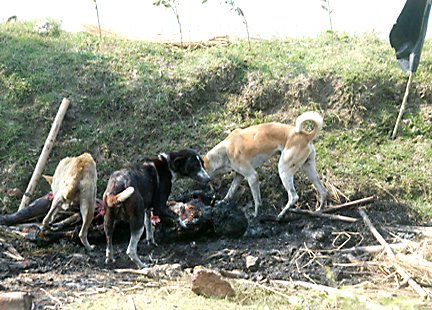
हम एक लोकतंत्र में रह रहे हैं! 14 मार्च को हुई घटना और उसके बाद सीपीएम के बंद के दौरान गायब हुए दो सौ लोगों का अब तक कोई अता-पता नहीं है्. हां। कुछ लाशें हैं जो इलाके में इस हालत में पायी गयी हैं. क्या हम बता सकते हैं कि इन्होंने किस बात की कीमत चुकायी? क्या हम इसको लेकर आश्वस्त रह सकते हं कि हमें भी कभी ऐसी ही कीमत नहीं चुकानी पड़ेगी?
Subscribe to:
Post Comments (Atom)
नंदीग्राम पर नयी फ़िल्म
यह फ़िल्म 14 मार्च की घटनाओं के सूक्ष्म विवरण के साथ आयी है.
देखें : नव उदारवाद का नया चेहरा बजरिये नंदीग्राम
देखें : विकास के नाम पर लोगों के उजड़ने की कहानी
उन्होंने मेरे पिता को टुकडों में काट डाला
देखें : न हन्यते
नंदीग्राम में 100 से ज्यादा लोग मारे गये हैं, 200 अब भी लापता हैं. वहां महिलाओं के साथ सीपीएम के कैडरों ने बलात्कार किया. बच्चों तक को नहीं छोड़ा गया है. सीपीएम की इस क्रूरता और निर्लज्जता का विरोध होना चाहिए. हमें नंदीग्राम, सिंगूर और हर उस जगह के किसानों के आंदोलन का समर्थन करना चाहिए, जो अपनी जमीन बचाने के लिए लड़ाई लड़ रहे हैं. यह दस्तावेज़ी फ़िल्म किसानों के इसी संघर्ष के बारे में है. यह फ़िल्म नंदीग्राम के ताज़ा नरसंहार से पहले बनायी गयी थी.
नंदीग्राम में जनसंहार के बाद के द्श्य
यह फिल्म पुलिस द्वारा नंदीग्राम में बर्बर तरीके से की गयी हत्याओं एवं उनकी भयावहता व बर्बरता के बारे में है. इसके कई दृ़श्य विचलित कर देनेवाले हैं.
नंदीग्राम प्रतिरोध्
नंदीग्राम में सरकारी आतंक
देखें : माकपा की गुंडागर्दी
नंदीग्राम में सीपीएम सरकार की पुलिस ने जो बर्बर कार्रवाई की, वह अब खुल कर सामने आने लगी है. यह फ़िल्म उसी बर्बरता के बारे में है. इसके कई दृश्य आपको विचलित कर सकते हैं. आप इसे तभी देखें जब आप वीभत्स दृश्य देख सकने की क्षमता रखते हों. हम खुद शर्मिंदा हैं कि हमें ऐसे दृश्य आपको दिखाने पड़ रहे हैं, पर ये आज की हकीकत हैं. इनसे कैसे मुंह मोडा़ जा सकता है?
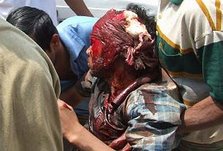
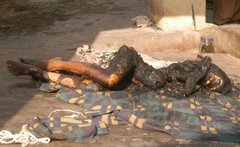
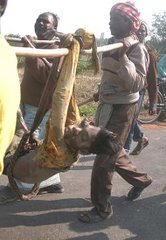
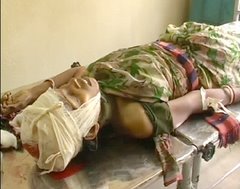

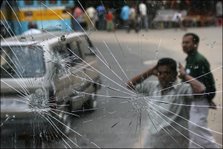
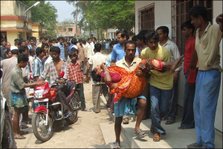

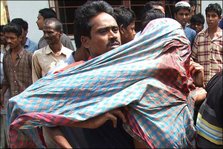


1 comment:
बांगलार नरेन्द्र मोदी ?
बुद्धदेव की बांगलार नरेन्द्र मोदी ?
वे पहले बुद्धदेव थे, फिर क्रुद्धदेव हुए और अब बुद्धूदेव साबित हुए हैं.
पिकासो ने अपनी गुएर्निका में सांडों को हिंसा और आतंक के प्रतीक के रूप में चित्रित किया है .
नंदीग्राम की निरीह गायों पर पगलाए सरकारी सांडों का स्तब्ध करनेवाला तांडव दीदे फाड़-फाड़ कर देखा आपने ?
भारत में वामपंथ के भविष्य का रास्ता क्या वाया नंदीग्राम जाता है ?
नंदीग्राम वह ‘स्पेस’ है जहां वामपंथ और मुक्त बाज़ार नशे की हालत में गलबहियां डाले खड़े पाए गए .
नंदीग्राम वह ‘स्पेस’ है जो कुछ दिनों तक एक तरह के ‘ग्राम स्वराज’ के अधीन था . जिसे बकौल बुद्ध बाबू दखल करना बहुत ज़रूरी था कानून की प्रतिष्ठा के लिए ‘क्योंकि सब्ज़ीवाले सब्ज़ियां नहीं बेच पा रहे थे.’ ( आश्चर्य मत करिये ये बुद्ध बाबू के शब्द हैं)
नंदीग्राम वह ‘स्पेस’ है जहां बीस हज़ार से भी ज्यादा किसान और ग्रामवासी अपने अस्तित्व पर होने वाले हमले को लेकर उद्विग्न थे और ‘मरता क्या न करता’ के तहत किसी भी कीमत पर ज़मीन देने को तैयार नहीं थे .
इस कृषिप्रधान देश के किसान का मन समझे बिना विकास की बात करने वाले विदेशी भाव-भूमि पर खड़े इन सूरदासों को क्या तो कहा जाए ?
किसान का मनोविज्ञान — उसका अपनी ज़मीन से जुड़ाव – न तो मुक्त व्यापार के समर्थक बाज़ारू किस्म के लोग समझ सकते हैं और न ही भ्रष्ट एवम आपराधिक चरित्र के राजनेता . हर पांच-दस साल में अपना घर/फ़्लैट बेचकर नई जगह बस जाने वाले वाले शहरी मध्यवर्ग से भी इसकी उम्मीद करना बेकार है कि वे ज़मीन के साथ किसान के इस भावनात्मक जुड़ाव को समझ पाएंगे .
तो किसान अब अपने को छोड़ किस पर उम्मीद रखे ? किस पर भरोसा करे ?
इसी नाउम्मीदी का नतीज़ा था नंदीग्राम के किसानों का प्रतिरोध . जिसने नंदीग्राम को एक ’आइसोलेटेड’ और ‘लिबरेटेड’ इलाके में बदल दिया . जहां अपनी पूरी मशीनरी के बावजूद प्रशासन घुस नहीं पा रहा था . कुछ माह पहले दो-तिहाई बहुमत से जीतने वाली और तीस साल से राज कर रही पार्टी के नुमाइंदे घुसने की हिम्मत नहीं जुटा पा रहे थे .
किसान बहुत धीरज धरने वाली कौम है. पर उसके धीरज का इम्तिहान लेने की भूल नहीं करनी चाहिये . उसके धीरज का बांध जब टूटता है तो तख्त उलट जाते हैं और नए इतिहास की रचना होती है .
सत्ता का चरित्र सब जगह एक-सा होता है . बुद्धदेव के बंगाल में भी वही हुआ जो नरेन्द्र मोदी के गुजरात में हुआ था . वीभत्स हत्याएं,शिशु हत्याएं और बलात्कार .
यह अकारण नहीं है कि कुछ दिनों से बुद्ध बाबू के मन में नरेन्द्र मोदी के लिए सम्मान भाव जाग्रत हो रहा था जो उनकी भाषा से भी रिस रहा था .
और इसी इनवेस्टमेंट-प्रेम, शिल्पायन-प्रेम और मोदी-प्रेम का नतीज़ा है नंदीग्राम .
सुप्रसिद्ध बांग्ला कवि जॉय गोस्वामी ने ‘बांग्लार नरेन्द्र मोदी’ यानी ‘बंगाल का नरेन्द्र मोदी’ कह कर उनकी भर्त्सना की है.
क्या आप इस तुलना से सहमत हैं ?
मैं असहमत हूं .
बुद्धदेव नरेन्द्र मोदी होना भी चाहें तो बंगाल उन्हें होने नहीं देगा .
पार्टी लाइन छोड़कर पूरा बंगाल खड़ा है नंदीग्राम के किसानों के साथ.
विपत्तियां अपने साथ अपना तोड़ भी लेकर आती हैं .
तीस सालों में पहली बार वाम मोर्चा ‘बैक फ़ुट’ पर है .
बंगाल के आम नागरिक और बुद्धिजीवी सड़कों पर उतर आए हैं.
जिसने यह दृश्य देखा है वही जान सकता है इसका प्रभाव.
महाश्वेता देवी,शंखो घोष,नवारुण भट्टाचार्य,जया मित्रा और जॉय गोस्वामी जैसे ख्यातनामा साहित्यकार ; सांओली मित्र,बिभास चक्रवर्ती,मनोज मित्र,मेघनाद भट्टाचार्य,अशोक मुखर्जी,चंदन सेन जैसे समाजचेता नाट्य व्यक्तित्व ; अपर्णा सेन ,गौतम घोष और शशि आनंद जैसे संवेदनशील फ़िल्मकार ; शुभप्रसन्न और जोगेन चौधुरी जैसे बड़े चित्रकार इसके लिए सड़कों पर उतर आए और सरकार को लानतें भेजीं. एक स्वर में धिक्कारा . विभिन्न सरकारी अकादमियों से अपने-अपने इस्तीफ़े दे दिये .
बिभास चक्रवर्ती ने कहा कि ‘बुद्धदेव के सफ़ेद कुर्ते पर खून के छीटे लगे हैं. वे लेडी मेकबेथ की तरह अब कितने बार भी धोएं उनके हाथों में रक्त लगा रहेगा .’
पश्चिम बंग सरकार द्वारा दिया गया बंकिम पुरस्कार लौटाते हुए वरिष्ठ कवि नवारुण भट्टाचार्य ने कहा कि मैं बुद्धदेव के त्यागपत्र की नहीं बल्कि इस अपराध के लिये ‘दृष्टांतमूलक शास्ति’ यानी ऐसी सज़ा की मांग करता हूं जो दूसरों के लिए एक उदाहरण का काम करे .
डॉक्टर,वकील,अध्यापक-प्राध्यापक और मीडियाकर्मियों से लेकर राजनैतिक गतिविधियों से दूर रहने वाले साधारण गृहस्थ, गृहणियां कौन नहीं आया सड़कों पर धिक्कार जताने .
यह अंतर है गुजरात और बंगाल में . गुजरात में ऐसा प्रबल प्रतिरोध दिखाई नहीं दिया . गांधीवादी तक चुप्पी खींच गये .
कोलकाता में सिंगूर और नंदीग्राम के लोगों के लिये चंदा मांग रहे कार्यकर्ताओं को लोग इस हिचक और इस शर्मिंदगी से ५०, १०० और ५०० रु. दे रहे थे मानो उनका भी कोई दोष है इस घटना में. शायद वे यह सोच रहे हों कि उनके वोटों से चुनकर आई इस सरकार की करनी का कुछ दोष तो उन पर आता ही है .
इसी लिए चाह कर भी बुद्धदेव भट्टाचार्य नरेन्द्र मोदी नहीं हो पाएंगे.
जाग्रत और सचेतन बंगाल उन्हें मोदी होने नहीं देगा .
उत्तर-गोधरा हिंसा ने मोदी को गुजरात में हीरो बना दिया .
नंदीग्राम की हिंसा ने बुद्धदेव को बंगाल में ज़ीरो बना दिया .
************
Post a Comment